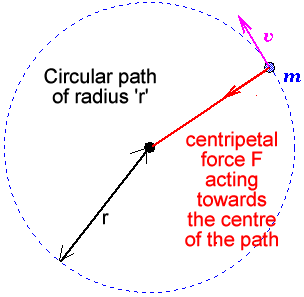Circular Motion:
The Basics:A body travels in a circular motion when it's distance passes in equal amounts of time along a circular path. In addition to this, the speed of the body remains constant whereas the velocity changes all the time. the reason being is that velocity is a vector where it has magnitude as well as DIRECTION. When velocity changes, we know that the body would then be accelerating.

As we can see from the image the centripetal force acts toward the centre of the circular path. The equation for centripetal acceleration is mv^2/r.
The speed of a body moving in a circle can be specified either by its speed along the tangent at any instant (linear speed) or by the angular velocity. The unit for angular velocity is rad s-1
The angular velocity is the time for the particle to travel around once divided by the period. ω = 2 π/T
Circular motion and the Large Hadron Collider:
The Large Hadron Collider (LHC) is the most powerful particle accelerator ever built. Based at the European particle physics laboratory CERN, near Geneva in Switzerland, it is the world’s largest laboratory and is dedicated to the pursuit of fundamental science.
Key Facts:
- It has a 27 km diameter.
- Weighs more than 38,000 tonnes
- 100 metres beneath the Swiss/French border at Geneva.
The LHC has a strong electric field making it the world’s most powerful particle accelerator and it creates collision energies 7x greater than previous machines. Then there are various types of superconducting magnets (9,300 in total) used to steer and focus the beams of particles as they race around the 27km loop of the LHC collider. There is a resultant force acting on the particles and that is the centripetal force whicg acts towards the centre of the collider (4.3km pictured below).

No comments:
Post a Comment